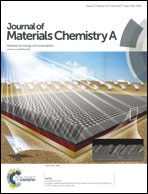High performance colored selective absorbers for architecturally integrated solar applications
Abstract
Architecturally integrated solar thermal technologies such as solar water heaters and solar thermoelectric generators (STEGs) rely on spectrally selective solar absorbers. These solar absorbers need to have simultaneous high solar absorptivity (α) and low thermal emissivity (ε), which always makes them look dark blue or black and so blocks architectural integrated solar applications. A colorful appearance should be taken into account for integration into architectural applications. Herein, colored absorbers with a TiNxOy absorbing layer and a TiO2/Si3N4/SiO2 dielectric stack are elaborately designed and can be fabricated with only two targets, Ti and Si, by using reactive magnetron sputtering. Both the theoretical and experimental results show that the color can be tuned a huge amount, while keeping solar absorptivity higher than 95% and thermal emissivity lower than 5%. The highest absorptivity and energy efficiency (α/ε) values are 97.6% and 27.2, respectively. These materials can also be fabricated onto thermoelectric generators to demonstrate the conversion of solar energy into electricity. The open circuit voltage dramatically increases from 171 mV to 523 mV (3.1 times) when using the absorbers. Additionally, the colored solar absorbers can be deposited onto most types of substrate, even flexible substrates. They can simultaneously satisfy the aesthetic requirements and excellent energy performance required for architecturally integrated solar thermal and thermoelectric applications, as well as applications in other fields.


 Please wait while we load your content...
Please wait while we load your content...